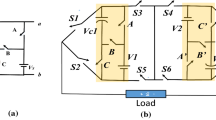Abstract
Multilevel technology is a good solution for medium- and high-voltage power conversion. There are three kinds of multilevel converters, namely diode clamped, capacitor clamped and cascade. Among them, capacitor-clamped multilevel converter is the most suitable topology for direct AC to AC conversion. This paper describes the modelling of a three-phase multilevel matrix converter with a capacitor-clamped topology having three flying capacitors per output phase. Venturini algorithm is used for generating gate pulses for this three-phase multilevel matrix converter, the application of which is different from the conventional three-phase single-cell matrix converter. Simulation results using the software PSCAD are presented. The simulation results for this three-phase multilevel matrix converter is compared with that for a three-phase conventional matrix converter and the total harmonic distortion in the two cases for the line to neutral output voltage, line to line output voltage and input current are tabulated. Simulation results indicate that the three-phase multilevel matrix converter has an improved performance compared to that of the three-phase conventional matrix converter.









Similar content being viewed by others
References
Alesina A, Venturini MGB (1981) Solid state power conversion: a fourier analysis approach to generalized transformer synthesis. IEEE Trans Circ Syst 28(4):319–330
Alesina A, Venturini M (1988) Intrinsic amplitude limits and optimum design of 9-switches direct PWM AC–AC converters. In: IEEE power electronics specialists conference, PESC’88, pp 1284–1291
Alesina A, Venturini M (1989) Analysis and design of optimum amplitude nine-switch direct AC–AC converters. IEEE Trans Power Electron 4(1):101–112
Wheeler P, Jose Rodriguez JC, Clare LE, Weinstein A (2002) Matrix converters—a technology review. IEEE Trans Ind Electron 49(2):276–288
Wheeler P, Clare J, Empringham L, Apap M, Bland M (2002) Matrix converters. Power Eng J 16(6):273–282
Sunter S, Altun H, Clare JC (2002) A control technique for compensating the effects of input voltage variations on matrix converter modulation algorithms. Electr Power Compon Syst Taylor Francis 30:807–822
Altun H, Sunter S (2003) Matrix converter induction motor drive: modeling, simulation and control. Electr Eng 86:25–33
Mohapatra KK, Jose P, Drolia A, Aggarwal G, Thuta S, Mohan Ned (2005) A novel carrier-based PWM scheme for matrix converters that is easy to implement. In: IEEE power electronics specialists conference, PESC’05, pp 2410–2414
Huber L, Borojevic D (1995) Space vector modulated three-phase to three-phase matrix converter with input power factor correction. IEEE Trans Ind Appl 31(6):1234–1245
Huber L, Borojevic D, Zhuang XF, Lee FC (1993) Design and implementation of a three phase to three phase matrix converter with input power factor correction. In: IEEE applied power electronics conference and exposition, APEC’93, pp 860–865
Casadei D, Serra G, Tani A, Zarri L (2002) Matrix converter modulation startegies: a new general approach based on space-vector representation of the switching state. IEEE Trans Ind Electron 49(2):370–381
Casadei D, Grandi G, Serra G, Tani A (1993) Space vector control of matrix converters with unity input power factor and sinusoidal input/output waveforms. In: European power electronics conference, pp 170–175
Casadei D, Serra G, Tani A, Zarri L (2006) A space vector modulation strategy for matrix converters minimizing the RMS value of the load current ripple. In: IEEE industrial electronics conference, IECON’06, pp 2757–2762
Hirota A, Nakaoka M (2006) A low noise three phase matrix converter introducing delta-sigma modulation scheme. In: 37th IEEE power electronics specialists conference, PESC’06, pp 1–6
Hirota A, Nagai S, Saha B, Nakaoka M (2008) Fundamental study of a simple control AC–AC converter introducing delta-sigma modulation approach. In: IEEE international conference on industrial technology, ICIT’08, pp 1–5
Hirota A, Nagai S, Nakaoka M (2008) Suppressing noise peak single phase to three phase AC–AC direct converter introducing delta-sigma modulation technique. In: IEEE power electronics specialists conference PESC’08, pp 3320–3323
Erickson RW, Al-Naseem OA (2001) A new family of matrix converters. In: 27th IEEE industrial electronics conference IECON’01, pp 1515–1520
Brackle D et al (2016) A modular multilevel matrix converter for high speed drive applications. In: Conference on power conversion and intelligent motion, Nuremberg, Germany, PCIM’16 Europe, pp 788–795
Shi Y, Yang X, He Q, Zhaoan W (2005) Research on a novel capacitor clamped multilevel matrix converter. IEEE Trans Power Electron 20(5):1055–1065
Rzasa J (2008) Capacitor clamped multilevel matrix converter controlled with Venturini method. In: 13th international power electronics and motion control conference (EPE-PEMC), pp 357–364
Iyer Narayanaswamy PR (2012) Modelling, simulation and real time implementation of a three phase AC to AC matrix converter. Ph.D. thesis, Chap VII, Curtin University, Perth, WA, Australia, pp 88–105
Manitoba HVDC Research Centre (2006) PSCAD version 4.2.1
Klumpner C et al (2002) A new matrix converter motor (MCM) for industry applications. IEEE Trans Ind Electron 49(2):325–335
Popovici A et al (2005) Modeling, simulation and design of input filter for matrix converters. In: WSEAS international conference on dynamical systems and control, pp 439–444
Arevalo Saul Lopez et al (2010) Control and implementation of A matrix-converter-based AC ground power-supply unit for aircraft servicing. IEEE Trans Ind Electron 57(6):2076–2084
Author information
Authors and Affiliations
Corresponding author
Rights and permissions
About this article
Cite this article
Iyer, N.P.R. Performance comparison of a three-phase multilevel matrix converter with three flying capacitors per output phase with a three-phase conventional matrix converter. Electr Eng 99, 775–789 (2017). https://doi.org/10.1007/s00202-016-0500-4
Received:
Accepted:
Published:
Issue Date:
DOI: https://doi.org/10.1007/s00202-016-0500-4




